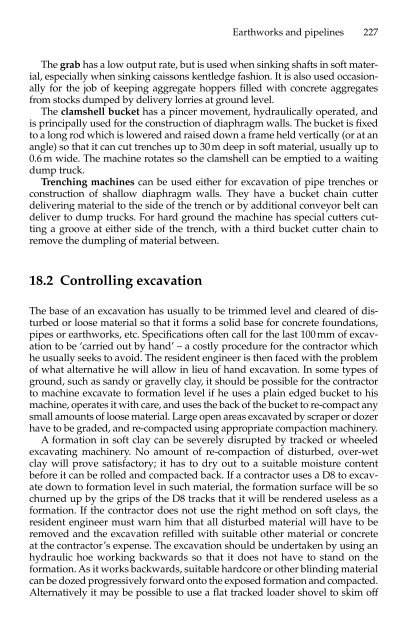Civil Engineering Project Management (4th Edition)
Create successful ePaper yourself
Turn your PDF publications into a flip-book with our unique Google optimized e-Paper software.
The grab has a low output rate, but is used when sinking shafts in soft material,<br />
especially when sinking caissons kentledge fashion. It is also used occasionally<br />
for the job of keeping aggregate hoppers filled with concrete aggregates<br />
from stocks dumped by delivery lorries at ground level.<br />
The clamshell bucket has a pincer movement, hydraulically operated, and<br />
is principally used for the construction of diaphragm walls. The bucket is fixed<br />
to a long rod which is lowered and raised down a frame held vertically (or at an<br />
angle) so that it can cut trenches up to 30 m deep in soft material, usually up to<br />
0.6 m wide. The machine rotates so the clamshell can be emptied to a waiting<br />
dump truck.<br />
Trenching machines can be used either for excavation of pipe trenches or<br />
construction of shallow diaphragm walls. They have a bucket chain cutter<br />
delivering material to the side of the trench or by additional conveyor belt can<br />
deliver to dump trucks. For hard ground the machine has special cutters cutting<br />
a groove at either side of the trench, with a third bucket cutter chain to<br />
remove the dumpling of material between.<br />
18.2 Controlling excavation<br />
Earthworks and pipelines 227<br />
The base of an excavation has usually to be trimmed level and cleared of disturbed<br />
or loose material so that it forms a solid base for concrete foundations,<br />
pipes or earthworks, etc. Specifications often call for the last 100 mm of excavation<br />
to be ‘carried out by hand’ – a costly procedure for the contractor which<br />
he usually seeks to avoid. The resident engineer is then faced with the problem<br />
of what alternative he will allow in lieu of hand excavation. In some types of<br />
ground, such as sandy or gravelly clay, it should be possible for the contractor<br />
to machine excavate to formation level if he uses a plain edged bucket to his<br />
machine, operates it with care, and uses the back of the bucket to re-compact any<br />
small amounts of loose material. Large open areas excavated by scraper or dozer<br />
have to be graded, and re-compacted using appropriate compaction machinery.<br />
A formation in soft clay can be severely disrupted by tracked or wheeled<br />
excavating machinery. No amount of re-compaction of disturbed, over-wet<br />
clay will prove satisfactory; it has to dry out to a suitable moisture content<br />
before it can be rolled and compacted back. If a contractor uses a D8 to excavate<br />
down to formation level in such material, the formation surface will be so<br />
churned up by the grips of the D8 tracks that it will be rendered useless as a<br />
formation. If the contractor does not use the right method on soft clays, the<br />
resident engineer must warn him that all disturbed material will have to be<br />
removed and the excavation refilled with suitable other material or concrete<br />
at the contractor’s expense. The excavation should be undertaken by using an<br />
hydraulic hoe working backwards so that it does not have to stand on the<br />
formation. As it works backwards, suitable hardcore or other blinding material<br />
can be dozed progressively forward onto the exposed formation and compacted.<br />
Alternatively it may be possible to use a flat tracked loader shovel to skim off


















